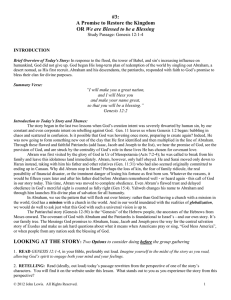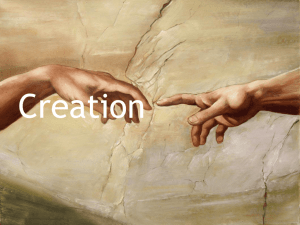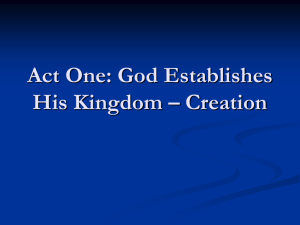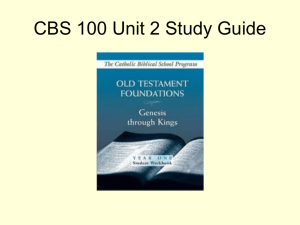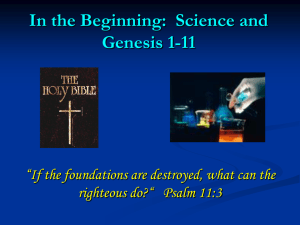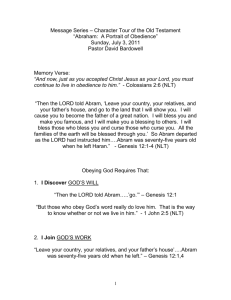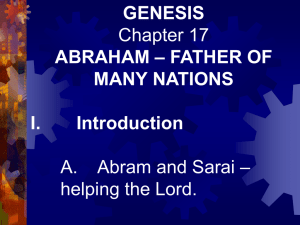- Gold Country Baptist Church
advertisement
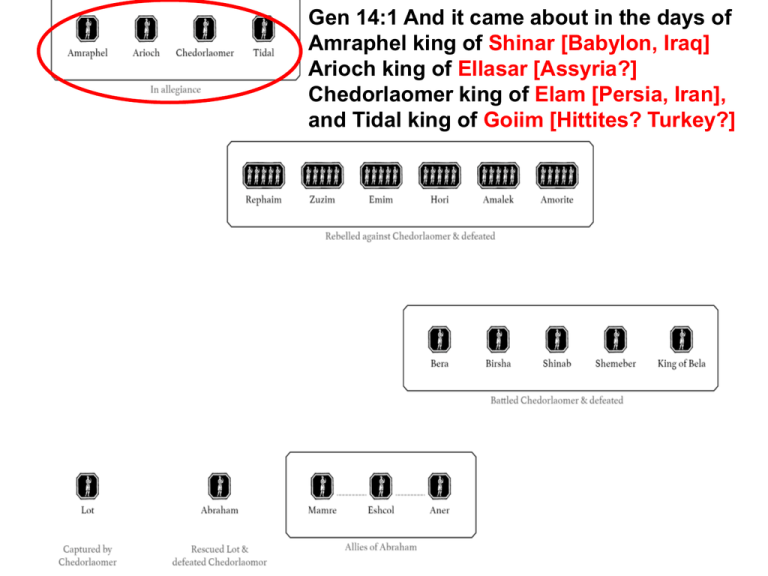
Gen 14:1 And it came about in the days of Amraphel king of Shinar [Babylon, Iraq] Arioch king of Ellasar [Assyria?] Chedorlaomer king of Elam [Persia, Iran], and Tidal king of Goiim [Hittites? Turkey?] Gen 14:1 And it came about in the days of Amraphel king of Shinar [Babylon, Iraq] Arioch king of Ellasar [Assyria?] Chedorlaomer king of Elam [Persia, Iran], and Tidal king of Goiim [Hittites? Turkey?] v. 2 that they made war with Bera king of Sodom, and with Birsha king of Gomorrah, Shinab king of Admah, and Shemeber king of Zeboiim, and the king of Bela (that is, Zoar). The first “Gulf War” involving Persians, Iraq, Iran, as far down as the Gulf of Aqaba Dead Sea Possible locations of Cities of the Plain in Genesis 14:2 Bible and Spade, Summer 1999, p. 67-80 Sodom Valley of Siddim Discovered by archaeology in 1924 by William Foxwell Albright Gomorrah Discovered by archaeology in 1973 Zoar Scholars have puzzled over Genesis 14 for generations. Some even said it was mythological — that is, until W. F. Albright researched it and found that it is very much authentic. Albright found that the names mentioned are authentic place names and personal names and the language throughout is very archaic [ancient, from the time period]. He concluded that it records an actual historical event during the days of Abraham. - Bible and Spade (1974) Volume 3/1, p. 10. Archaeology overturns the critics • Critics once scoffed that there wasn’t writing yet in the time of Moses to write Genesis but 17,000+ tablets with writing have been found since 1974 dated to 2500 BC well before time of Abram! • Gen. 14:2 refers to the 5 cities of the Plain (Sodom, Gomorrah, Admah, Zeboiim, Zoar), verified by Ebla archives, one scholar claimed even in same order • Many names of people and places in Genesis were found in Ebla (ex: Salem in Gen 14:18, etc.) • Another text from different area dated to 1900 B.C. confirms Ashteroth (v. 5) around the time of Abram • Some critics questioned whether “Hebrew” (in v. 13) was a term used that early in history, but later archaeology has found texts using the word Hebirew as early as 1750 B.C., close to the time of Abraham. Archaeological Study Bible, p. 23-25: ‘These cities were not mythical places but historical sites, and there is evidence of their destruction precisely as the Bible describes … We know [Zoar’s] location from the Medeba map, a mosaic map on the floor of a church in Madaba, Jordan, depicting the Holy Land … during the sixth century … the name Arioch [v. 1] is rendered … in 18th–15th century [BC] texts discovered at Mari and Nuzi in Mesopotamia … Contemporary records [of the time of Abram] trace similar Mesopotamian confederations that formed’ Beni Hasan Tomb Painting Painting dated to 1900 B.C. shows people from Canaan and the weapons they might have used in warfare (Gen 14) ex: Axes, spears, bow & arrow, etc. Genesis 14:3 All these [cities of v. 2] came as allies to the valley of Siddim (that is, the Salt Sea) [or Dead Sea]* *Many believe the valley of Siddim and cities in v. 2 are now under the southern Dead Sea Read Genesis 14:4-5 Places in Genesis 14:5 Places in Genesis 14:6-8 Below is valley near Salt Sea (Dead Sea) today Southern Dead Sea (Holman Bible Atlas) Dead Sea western cliffs to south from En Gedi Read Genesis 14:8-9 Dead Sea Valley of Siddim Genesis 14:10–11: “Now the valley of Siddim was full of tar pits; and the kings of Sodom and Gomorrah fled, and they fell into them. But those who survived fled to the hill country. Then they took all the goods of Sodom and Gomorrah and all their food supply, and departed.” Dead Sea mud terraced shoreline ‘That the southern end of the Dead Sea is a source of bitumen [tar or black asphalt-type susbtance] is a well established fact. The historians Diodoros, Strabo, Josephus, and Tacitus wrote of large masses of asphalt coming to the surface of the water in the sector of the Dead Sea below the Lisan. Similar phenomena have been observed in modern times as well.’ -- Bible and Spade (1974) Volume 3/3, p. 79. Traditional site of “Oak of Abram” (Gen. 14:13) in Mamre, as of 1847 Read Genesis 14:12-13 • ‘The Hebrew text [about Abram’s alliance at the end of v. 13] means they had a covenantal relationship with him. Indeed, in those days even to live there temporarily required a treaty. This, in turn, shows Abram’s strength, materially (in wealth) and physically (in manpower), for certain inhabitants of the Land to make this treaty with him. But this treaty also required the other three covenantal parties to join him in battle, and they now honored this treaty and did so. These may also have been Abram’s converts in the worship of Jehovah.’ [see Genesis 12:3] – Arnold G. Fruchtenbaum, Ariel's Bible Commentary: The Book of Genesis, 1st ed. (San Antonio, TX: Ariel Ministries, 2008), 265. Abram’s pursuit of the eastern kings and rescue of Lot • Dan Read Genesis 14:14-16 • Shechem • •Ai Bethel Hebron Beer-sheba • • Sodom and • Gommorah? Archaeology has found in Dan (v. 14) a 4000year-old mud-brick gate from the very timeframe when Abram travelled through Note the descendants of Abram come through some of the same areas after Exodus that the kings defeated in Gen 14 Note: Shinar is in Genesis 11:2 the place where men united in rebellion against God at the Tower of Babel. In Genesis 14:1 there is another alliance of sinful men to build a kingdom and make a name for themselves (see Genesis 11:4) Gen 14:1 And it came about in the days of Amraphel king of Shinar [Babylon, Iraq], Arioch king of Ellasar [Assyria?] Chedorlaomer king of Elam [Persia, Iran], and Tidal king of Goiim [Hittites? Turkey?] Gen 14:1 And it came about in the days of Amraphel king of Shinar [Babylon, Iraq], Arioch king of Ellasar [Assyria?] Chedorlaomer king of Elam [Persia, Iran], and Tidal king of Goiim [Hittites? Turkey?] But God calls Abram from Iraq (Ur) and promises He will make Abram’s name great and all nations will be blessed in Abram (Genesis 12:1-3) Gen 14:1 And it came about in the days of Amraphel king of Shinar [Babylon, Iraq], Arioch king of Ellasar [Assyria?] Chedorlaomer king of Elam [Persia, Iran], and Tidal king of Goiim [Hittites? Turkey?] Daniel 4 suggests another notable man from Babylon is saved. Psalm 87:4 indicates others from this land also came to know God, who says: “Among those who know me I mention Rahab and Babylon.” (Psalm 87:4 ESV) God’s grace comes to Assyria later by the prophet Jonah and Nineveh repents. An even bigger mass salvation in Assyria seems prophesied in Isa 19:24-25 where Assyria will be with Israel “a blessing in the midst of the earth … whom the Lord of hosts has blessed saying, ‘Blessed is … Assyria, the work of my hands, and Israel my inheritance.’” Gen 14:1 And it came about in the days of Amraphel king of Shinar [Babylon, Iraq], Arioch king of Ellasar [Assyria?] Chedorlaomer king of Elam [Persia, Iran], and Tidal king of Goiim [Hittites? Turkey?] In Matthew 2, Magi from the East come to the promised land, but this time coming to worship Jesus the newborn King. Some think they came from the area of Babylon or Elam. Wherever they came from it is a fulfillment of Abram’s promise in Gen. 12:3, including formerly enemy nations (see Gal. 3) Gen 14:1 And it came about in the days of Amraphel king of Shinar [Babylon, Iraq], Arioch king of Ellasar [Assyria?] Chedorlaomer king of Elam [Persia, Iran], and Tidal king of Goiim [Hittites? Turkey?] Some converts to Abram’s faith from Elam and other Persians/Arabs are among those saved in Acts 2:911 when they hear the gospel from descendants of Abraham on the day of Pentecost, in fulfillment of Genesis 12:3 (see also Gal. 3:8-29) Gen 14:1 And it came about in the days of Amraphel king of Shinar [Babylon, Iraq], Arioch king of Ellasar [Assyria?] Chedorlaomer king of Elam [Persia, Iran], and Tidal king of Goiim [Hittites? Turkey?] Gen 14:1 And it came about in the days of Amraphel king of Shinar [Babylon, Iraq], Arioch king of Ellasar [Assyria?] Chedorlaomer king of Elam [Persia, Iran], and Tidal king of Goiim [Hittites? Turkey?] A number of Goiim (Gentiles) come to faith and join Israel in the time of David. A notable faithful godly soldier of David’s is Uriah the Hittite, who demonstrates truer godliness than David (2 Samuel 10-11) Genesis 14 and Jesus’ family tree • Matthew’s gospel introduces Jesus as “son of Abraham” (1:1) and ends with the same phrase “all nations” (28:19) as Abraham’s promise in Genesis 12:3 • The genealogy of Jesus then includes many people from nations in Gen 14: – Abraham (Matt 1:2) was from Ur in Babylon (part of land mentioned in Gen 14:1) – Isaac (Matt 1:2) married from Syria (Gen 25:20), where Damascus is (Gen 14:15) – Jacob (Matt 1:2) married someone from Haran (Gen 29), modern Turkey (Gen 14:1) – Tamar and Rahab are both Canaanites (Mt 1:3, 5), the land where Abram is dwelling in, Gen 14 – Ruth is a Moabite (Matt 1:5) from the land the kings pass through in Genesis 14 – The wife of Uriah the Hittite (Mt 1:6, people group in Gen 14:1?) “By faith Abraham … let us run the race … fixing our eyes on Jesus, the author and perfecter of faith” (Heb 11:8, 12:2) Damascus Genesis 14:15 describes Abram the Hebrew on a road to Damascus pursuing Lot to rescue him Acts 9 describes a later “Hebrew of Hebrews,” a descendant of Abraham also on a road to Damascus, when Jesus, the Son of Abraham, comes and pursues Saul and rescues him!
